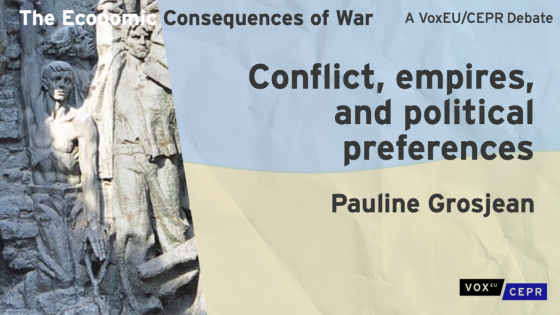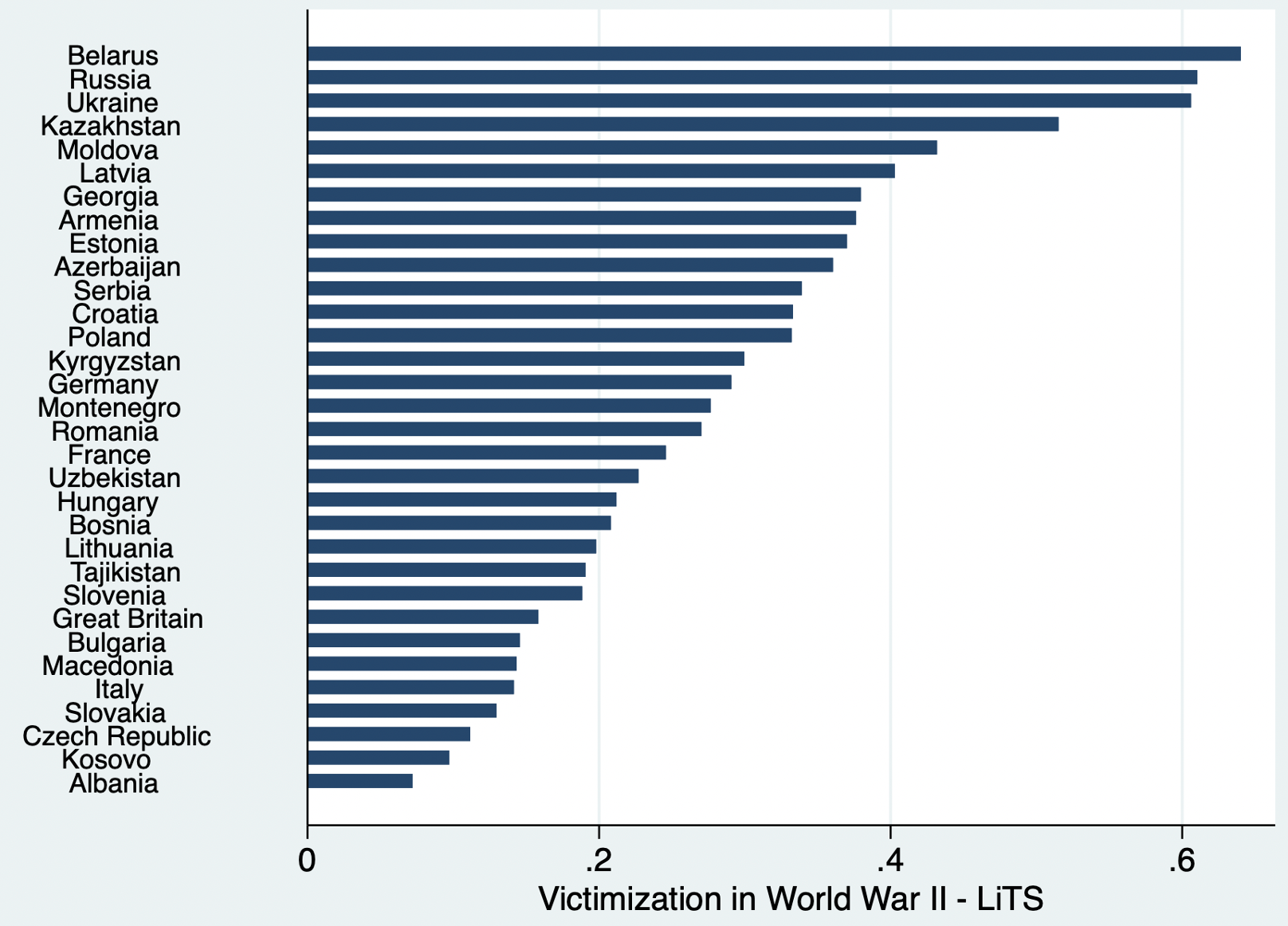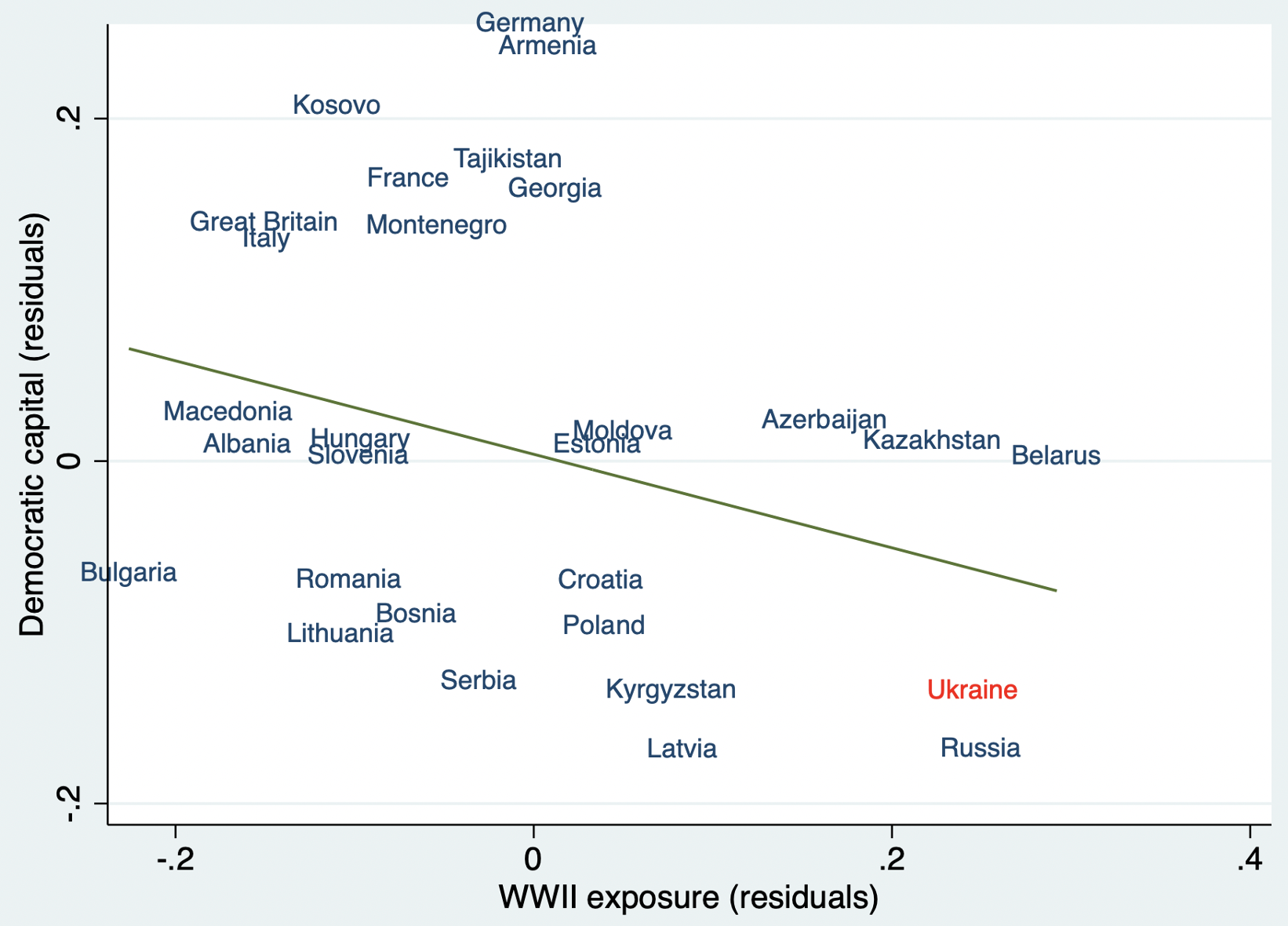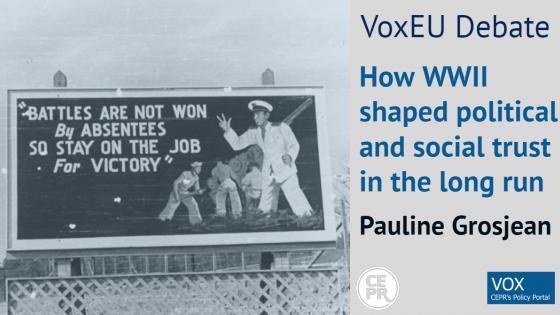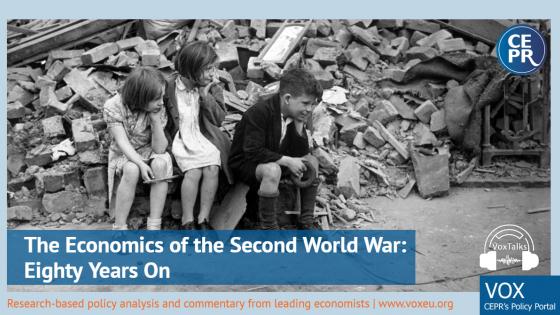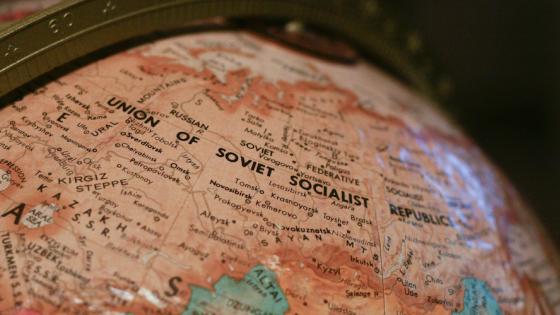Editors' note: This column is part of the Vox debate on the economic consequences of war.
The consequences of the Russian invasion of Ukraine will outlast the conflict itself. Conflict has enduring consequences on economic, social, and political outcomes. The effects on individuals and families are similarly persistent, and remain over generations (Blattman and Miguel 2010, Bauer et al. 2014, Grosjean 2014, Couttenier et al. 2019).
In a chapter of the VoxEU eBook on The Economics of the Second World War published in 2019, I discussed the long shadow of victimisation in WWII on political trust and social preferences. I focused on the political and social norms that are most critical for long-run economic growth and political stability. For example, trust in formal institutions is a key determinant of economic growth (Acemoglu 2005, Acemoglu et al. 2011, Besley and Persson 2009, 2010), market development (Greif 2012), economic liberalisation (Grosjean and Senik 2011), and post-conflict political recovery (Bigombe et al. 2000). Trust in others and social cohesion are also crucial factors in growth (Knack and Keefer 1997, Guiso et al. 2010), the functioning of markets (Fafchamps 2006) and institutional quality (Tabellini 2008, 2010).
A representative sample of respondents across 35 countries surveyed in 2010, 65 years after the end of the war, shows that a family history of wartime victimisation has systematically eroded political trust and the perceived legitimacy of institutions (Grosjean 2014, Grosjean 2019). Trust in government institutions is strongly and negatively associated with a family history of wartime victimisation. The effect is similar on perceived fairness of the courts. These effects hold regardless of the war’s outcome for the country, are persistent across generations – effects are still found among the grandchildren of those directly affected by the conflict – and are large in magnitude. Today, people whose families were victimised in the war are less trusting of the central state and of the courts by 0.07 and 0.08 standard deviations, compared with others with similar socioeconomic characteristics in the same locality. For trust in the central state, this is nearly five times the effect of being unemployed; for trust in the courts, it is ten times.
Greater exposure to violence has also made people more likely to engage in political and social groups and in collective action by, for example, demonstrating, striking, or signing petitions. Again, the fate of the nation at the war’s end has no strong influence and the effect is multigenerational.
What does such involvement in collective action and in social and political groups capture? The sociological literature is divided. Putnam (1995) sees it as promoting social cohesion. Bourdieu (1985) saw the opposite: social capital can be exploited in group rivalry, leading to social exclusion and political violence (see also Portes 1998). Recently the “dark side” of social capital has been unveiled by Satyanath et al. (2013): the density of civic associations in interwar Germany helped advance the Nazi Party to power. Similarly, victims of the 1990s Tajik civil war participate more in groups when they have less trust in other people and the state (Cassar et al. 2013a, b).
In the case of those whose families were victimised in WWII, the evidence suggests that collective action spurred by this victimisation may be similarly dark in nature. In families that were victimised, people who participate in groups today are those that place less trust in others as well as in politics (Grosjean 2014: 447-448).
Overall, this research highlights the negative and enduring effects of victimisation on political trust and on social cohesion, crucial determinants of long-run stability and society.
Different histories of wartime victimisation
My previous analyses purposefully abstracted away from possible macro-level effects of conflict on the quality of political institutions and on social capital. Relying on the Life in Transition Survey (LITS), a nationally representative survey carried out in 2010 in more than 30 countries of former Communist Europe and Central Asia, as well as a handful of Western countries, I compared reported institutional trust and social capital proxies by individuals from the same town, some of whom reported victimisation in their family and others not. The victimisation question asked whether the respondent, their parents or their grandparents were physically injured or killed during WWII. By focusing on people in the same town, a fortiori in the same country, I was able to compare the attitudes of individuals who faced the same institutions and to minimise the influence of other factors, such as cultural norms, that could confound the relationship of interest.
Yet, there is also great variability in the extent of victimisation during WWII across Europe, and such cross-country variation may be instructive. The former USSR suffered the greatest loss in human life, with 7.5 million reported battle deaths (Sarkees and Wayman 2010) and total deaths (civilian and military) in the 26-27 million range (Ellman and Maksudov 1994). Looking at family victimisation reported in 2010, three successor states to the USSR stand out: Belarus, Russia, and Ukraine (Panel B of Figure 1). 64% of surveyed respondents in Belarus report having had a family member killed or injured as a result of WWII, 61% in Russia and 60% in Ukraine.
Figure 1 History of family victimisation in WWII
Notes: The figure plots the share of respondents at country level who answer yes to the following question: “Were you, your parents or any of your grandparents physically injured or killed during the Second World War?” At the country level, the frequency of self-reported victimisation is highly correlated with independent measures of war-related fatalities, even adjusting for the evolution of potential exposure across generations (Grosjean 2014: 436).
Source: Life in Transition Survey, 2010.
Alongside this high victimisation, Ukraine is also among the countries that scored lowest on political trust in 2010 compared with the rest of the sample (normalised measure2 of political trust: -0.39, sample average outside Ukraine: 0.018, P-value difference in means <0.001, with only Romania and Uzbekistan scoring lower in the sample) and highest on our measures of membership in groups (normalised measure: -0.21, sample average outside Ukraine: -0.01, P-value difference in means <0.001). Ukraine was also among the countries where support for democracy, or democratic capital, was lowest, as illustrated in Figure 2. On average, respondents in Ukraine agreed less than the sample average with the statement that “a democracy is the best political system” (normalised measure: -0.30, sample average outside Ukraine: 0,01, P-value difference in means <0.001).
Admittedly, the situation in Ukraine in 2010 was very different from what it was ten years later. Notwithstanding the aspirations that the 2014 Maidan Revolution embodied and the progress achieved since then, Ukraine was still, in the 2016 wave of the Life in Transition Survey, among the countries with the lowest trust in central institutions (normalised measure: -0.63, sample average outside Ukraine: 0.02, P-value difference in means <0.001) and the lowest average support for democracy (normalised measure: -0.22, sample average outside Ukraine: 0.01, P-value difference in means <0.001).
Figure 2 Cross-country relationship between democratic capital and family history of victimisation in WWII
Notes: This figure plots the residuals of a cross-country regression of support for a democratic system (share of respondents who agree with the following statement: a Democracy is the best political system) against the residuals of a regression of family exposure to WWII (horizontal axes), controlling for individual characteristics (age, age squared, gender, education, working status, household size, religion, mother tongue). Standard errors are adjusted for clustering at the country level.
Ukraine: At the confluence of enduring historical legacies
The literature has also documented the enduring influence of pre-WWI empires of Central and Eastern Europe on political and social trust (Grosjean 2011a), economic institutions and development (Grosjean 2011b), corruption (Becker et al. 2016), and attitudes towards democracy (Grosfeld and Zhuravskaya 2015).
Many present-day countries of Central and Eastern Europe had at one time been divided between several empires, with many borders of present-day countries the result of sometimes arbitrary military advances and peace treaties. Poland, for example, had been divided among three empires – Russia, Austria-Hungary, and Prussia – for over a century until 1918 (Grosfeld and Zhuravskaya 2015) and its borders redrawn after WWII (Becker et al. 2020). Modern-day Ukraine had been divided between Russia and Austria-Hungary, while parts of Ukraine had also been under Ottoman rule until the end of the 18th century.
Becker et al. (2016) document positive effects of Habsburg rule on political trust in the sample of countries that were divided between the Habsburg and another empire (Poland, Ukraine, Romania, Serbia, Montenegro). Grosfeld and Zhuravskaya (2015) highlight an enduring higher preference for democracy in parts of Poland that were under Austrian rule compared to those under Russian rule, although they find no difference between parts that were ruled by Russia versus Prussia. Looking more specifically at Ukraine seems to point to similar results. Political trust and democratic capital, measured in 2010, were 0.26 and 0.21 standard deviations lower in the formerly Russian parts compared to parts ruled by Austria-Hungary. This is the case even after controlling for potential differences in religious affiliation, mother tongue, income, or education.
Conclusion
Ukraine at the dawn of the 21st century stood at the confluence of enduring legacies of a divided and violent past. It had been divided between several empires at the eve of WWI and experienced among the highest levels of victimisation in the 20th century in Europe and the former USSR (Snyder 2011). Some authors have warned of conflict traps (Collier 2003), in which the negative consequences of one conflict provide the seeds for further devastation. This column illustrates the potential for such a trap by showing the negative and enduring effects of victimisation on political trust, social cohesion, and democratic capital. But Ukraine is also the victim of another trap: former empires not only influence political preferences, but also directly cause political instability and conflict when rulers politicise the dream of recreating them. Border regions of former empires are risky places. And given the history of imperial border changes in Europe, few places are immune to this risk.
Author’s note: I thank Alice Calder and Federico Masera for insightful comments.
References
Acemoglu, D (2005), “Politics and economics in weak and strong states”, Journal of Monetary Economics 52(7): 1199–1226.
Acemoglu, D, D Ticchi and A Vindigni (2011), “Emergence and persistence of inefficient states”, Journal of the European Economic Association 9(2): 177–208.
Besley, T and T Persson (2009), “The origins of state capacity: Property rights, taxation and politics”, American Economic Review 99(4): 1218–1244.
Besley, T and T Persson (2010), “State capacity, conflict and development”, Econometrica 78(1): 1–34, 01.
Bigombe, B, P Collier and N Sambanis (2000), “Policies for building post-conflict peace”, Journal of African Economies 9(3): 323–348.
Bauer, M, A Cassar, J Chytilová and J Henrich (2014), “War’s enduring effects on the development of egalitarian motivations and in-group biases”, Psychological science 25(1): 47-57.
Blattman, C and E Miguel (2010), “Civil war”, Journal of Economic Literature 48(1): 3-57.
Becker, S, K Boeckh, C Hainz and L Woessmann (2016), “The Empire Is Dead, Long Live the Empire! Long-Run Persistence of Trust and Corruption in the Bureaucracy”, The Economic Journal 126(590): 40-74.
Becker, S O, I Grosfeld, P Grosjean, N Voigtländer and E Zhuravskaya (2020), "Forced Migration and Human Capital: Evidence from Post-WWII Population Transfers", American Economic Review 110(5): 1430-63.
Bourdieu, P (1985), “The social space and the genesis of groups”, Social Science Information 24(2): 195–220.
Cassar, A, P Grosjean and S Whitt (2013a), “Legacies of violence: Trust and market development”, Journal of Economic Growth 18(3): 285–318.
Cassar, A, P Grosjean and S Whitt (2013b), “Social preferences of ex-combatants: Survey and experimental evidence from post-war Tajikistan,” in K Wärneryd (ed), The Economics of Conflict, MIT Press: Cambridge, MA.
Collier, P, L Elliot, H Hegre, A Hoeffler, M Reynal-Querol and N Sambanis (2003), Breaking the conflict trap: civil war and development policy, Oxford University Press and World Bank: Oxford and Washington DC.
Couttenier, M, V Petrencu, D Rohner and M Thoenig (2019). “The violent legacy of conflict: evidence on asylum seekers, crime, and public policy in Switzerland”, American Economic Review 109(12): 4378-4425.
Ellman, M and S Maksudov (1994), “Soviet Deaths in the Great Patriotic War: A Note”, Europe-Asia Studies 46(4): 671-680.
Fafchamps, M (2006), “Development and social capital”, Journal of Development Studies 42(7): 1180–1198.
Greif, A (2015), “Coercion and exchange. How did markets evolve?” in Greif, A, L Kiesling and J Nye (eds), Institutions, Innovation, and Industrialization: Essays in Economic History and Development, Princeton University Press.
Grosfeld, I and E Zhuravskaya (2015), “Cultural vs. Economic Legacies of Empires: Evidence from the Partition of Poland”, Journal of Comparative Economics 43(1): 55-75.
Grosjean, P (2011a), “The institutional legacy of the Ottoman Empire: Islamic rule and financial development in South Eastern Europe”, Journal of Comparative Economics 39(1): 1-16.
Grosjean, P (2011b), “The Weight of History on European Cultural Integration: A Gravity Approach", American Economic Review 101(3): 504-508.
Grosjean, P (2014), “Conflict and social and political preferences: Evidence from World War II and civil conflict in 35 European countries”, Comparative Economic Studies, 56(3): 424-451.
Grosjean, P (2019), “How WWII shaped political and social trust in the long run”, VoxEU.org, 9 September.
Grosjean, P and C Senik (2011), “Democracy, market liberalization and political and economic preferences”, Review of Economics and Statistics 93(1): 365–381.
Grosjean, P (2014), "Conflict and Social and Political Preferences: Evidence from World War II and Civil Conflict in 35 European Countries", Comparative Economic Studies 56(3): 424–451.
Guiso, L, P Sapienza and L Zingales (2010), “Civic capital as the missing link” in Benhabib, J, A Bisin and M O Jackson (eds), Social Economics Handbook, National Bureau of Economic Research.
Knack, S and P Keefer (1997), “Does social capital have an economic payoff? A cross-country investigation”, Quarterly Journal of Economics 112(4): 1251–1288.
Portes, A (1998), “Social capital: Its origins and applications in modern sociology”, Annual Review of Sociology 24: 1–24.
Putnam, R D (1995), “Bowling alone: America’s declining social capital”, Journal of Democracy 6(1): 65–78.
Satyanath, S, N Voigtlaender and H-J Voth (2013), “Bowling for fascism: Social capital and the rise of the Nazi party in Weimar Germany, 1919–33”, NBER Working Paper No. 19201.
Snyder, T (2011), Bloodlands: Europe between Hitler and Stalin, Random House.
Tabellini, G (2008), “The scope of cooperation: Norms and incentives”, Quarterly Journal of Economics 122(3): 905–950.
Tabellini, G (2010), “Culture and institutions: Economic development in the regions of Europe”, Journal of the European Economic Association 6(2–3): 255–294.
Endnotes
1 I normalise all measures to have mean 0 and standard deviation of 1.
